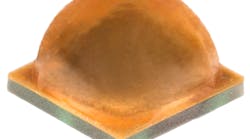Nichia asserts that optimized crystal growth technology is enabling the company to offer superior UV-C LEDs for sterilization while RayVio has a new UV-B SSL product for skin treatment, and Lumileds targets the other end of the spectrum with an IR LED for applications such as machine vision.
Nichia has announced the NCSU334A packaged LED that emits at 280 nm in the ultraviolet (UV) range and specifically in the UV-C band that enables instantaneous sterilization and purification for air, fluids, and surfaces. For medical phototherapy applications, RayVio has new LEDs that emit at 308 nm. Lumileds, meanwhile, has announced a new infrared (IR) LED family that spans the range of 850–940 nm enabling a solid-state lighting (SSL) approach to applications such as security and vision systems.
Nichia UV technology
Still, Nichia has been relatively quiet in terms of the UV market. The new LED, however, is packaged in a 6.8×6.8-mm footprint and delivers what the company believes is among the top UV-C performance in the SSL sector. The product delivers 55 mW of radiometric power output when driven at 350 mA. That level of performance would certainly place Nichia among the leaders in terms of power output.
But output power is only one of the issues associated with UV LEDs. The products trail visible-light LEDs in terms of reliability and cost significantly more. Moreover, the shortest-wavelength UV-C (100–280 nm) LEDs have been the most problematic in terms of commercialization while the application potential in destroying pathogens is enormous.
Clearly, however, the LED manufacturers are making progress and product developers in the UV space have to think differently about UV system design relative to similar systems based on legacy sources, because the operational scenarios differ, as we covered in a feature article last year.
Nichia hasn’t revealed detailed lifetime projections for the new product. But Erik Swenson, general manager of Nichia America, said expectations are that the UV LEDs will afford 10,000 hours longer life than do legacy UV-C sources (per initial testing under Nichia's conditions and environment). That would suggest that the LED will be viable in applications such as water sterilization. Products for sterilization based on LEDs are just rolling into the market and LEDs will enable deployment even in residential-targeted products, as we wrote recently.
As for how Nichia achieved the performance and reliability levels described above, the company cited its history in UV-A (315–400-nm) LED applications such as curing. The company was able to apply lessons learned in crystal growth to the shorter-wavelength emitters. And the company said it developed a new hermetically-sealed package that enables the reliable operation in harsh environments.
UV-B LEDs for skin treatment
RayVio has previously been more focused on UV-C applications. The company has touted its work in such LEDs packaged using mid-power LED technology. Those product lines actually straddle the UV-B and -C regions and application markets. The company was also the first to demonstrate UV LEDs near 50 mW.
IR LEDs for biometrics, security, and more
IR LEDs share a trait with UV LEDs in that both lie outside the human visual range, but the two fall on either end of the spectrum. Lumileds’ new Luxeon IR 2720 LEDs are available in 850- and 940-nm versions. Maximum radiometric power is 1250 and 1300 mW, respectively.
As the model number implies, the LEDs are packaged in a 2.7×2.0-mm footprint. The package does not include a domed primary optic that leads to a relatively wide 120° beam pattern. Moreover, the lack of an optic enables more compact SSL system designs.
Lumileds said specific target applications include security cameras, machine vision, iris scanning for biometric usages, and human health monitoring. And the new LEDs are in a cost-effective and small package that can support that application range.
“Infrared LED uses such as CCTV cameras and machine vision are especially cost-sensitive markets, so high-performance emitters with high reliability are very much in demand,” said Ryan Dong, product manager at Lumileds. “The Luxeon IR 2720 package enables drop-in upgrades in applications that require high punch, long range, and high uniformity including positioning and depth measurement, and industrial automation.” Moreover, the company said a state-of-the-art thermal resistance package of 4°C/W eliminates thermal issues and that the company has put the components through a rigid qualification process to ensure reliability.
As is the case for UV LEDs, the IR products enable some very compelling application scenarios. For example, the technology can enable facial recognition and even monitor driver attention span in an automobile.
Editor’s note:For more insight into packaged LED technology and advances in performance, see our feature that rounds up the latest developments through fall 2018, which demonstrated a move toward mid-power LEDs, chip-scale packages, and a focus on significant light quality improvements that enable specialty applications.
*Updated Apr. 23, 2019 12:31 PM for a clarification on Nichia lifetime claims and RayVio output power range.









